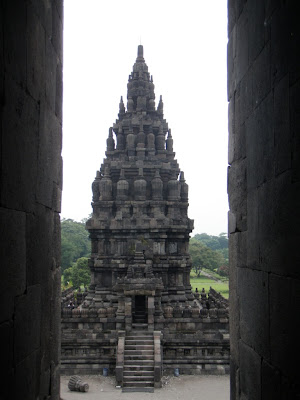We set out to Prambanan, about 17 km east of Yogyakarta, to visit the largest Hindu temple complex in Indonesia. Built in the 10th century, the temple is a UNESCO World Heritage Site. It is characterised by its collection of sharp, jagged pyramids instead of the vast horizontal bulk of Borobudur. Entry fee to Prambanan is Rp1,000,000 for foreigners, more than 10x compared to what locals pay. Quite a rip-off, if you ask me.
The main attractions are six temples of the central court, richly decorated with carved reliefs. The three main temples, known as the Trisakti ("three sacred places"), are Candi Shiva, rising to a height of 47 meters and dedicated to Shiva the Destroyer, Candi Brahma and Candi Vishnu. Each main temple has an accompanying smaller temples dedicated to the vehicles of the gods, namely Nandini for Shiva, Angsa for Brahma, and Garuda for Vishnu. Only the statue of Nandini, Shiva's bull, has survived. However, in the wake of the May 2006 Java earthquake, some parts of Prambanan sustained significant damage and are cordoned off for restoration and stabilization. We were only allowed entry into two of the six temples.
The main attractions are six temples of the central court, richly decorated with carved reliefs. The three main temples, known as the Trisakti ("three sacred places"), are Candi Shiva, rising to a height of 47 meters and dedicated to Shiva the Destroyer, Candi Brahma and Candi Vishnu. Each main temple has an accompanying smaller temples dedicated to the vehicles of the gods, namely Nandini for Shiva, Angsa for Brahma, and Garuda for Vishnu. Only the statue of Nandini, Shiva's bull, has survived. However, in the wake of the May 2006 Java earthquake, some parts of Prambanan sustained significant damage and are cordoned off for restoration and stabilization. We were only allowed entry into two of the six temples.


Top: Piles of stones still lie around the temple complex awaiting reconstruction but according to the guide, it's nearly impossible to reconstruct the temple complex fully as they have to piece each stone one by one, and there's no marking on the stones. Bottom: The "male" and "female" mechanism that holds the stones together.

 Reconstruction work in progress
Reconstruction work in progress




Candi Sewu complex, the second largest Buddhist temple in Indonesia after Borobudur, is one kilometer north of Prambanan. It consists of 240 shrines arrayed around a central temple. The sheer size of the recently renovated and intricately decorated central temple is impressive, but the statue niches are all empty. The fact that this temple was built near Prambanan Temple which is Hindu Temple indicated that the Hindus and Buddhist lived in harmony.


The ticket to Prambanan includes a visit to the Kraton Ratu Boko, 3 km south of Prambanan. Only some building foundations remain in this ruined palace located on a hilltop 200 meters above the Prambanan plain.

We had initially wanted to visit Solo, about two hours drive away from Prambanan but by the time we were done with Kraton Ratu Boko, it was almost 2pm so we decided to ditch the idea to visit several other surrounding temples. About 1km away from Prambanan is the Plaosan temple complex, with the North and South Plaosan temples. Both temples appear similar when seen from the distant so the Plaosan temple is also known as the twin temples.



We then left Prambanan area and headed back onto the main Yogyakarta – Solo road and stopped for lunch at a restaurant that caught our fancy. After refuelling our tummy, we went in search of the Kedulan temple. I’m not sure if the driver took us to the wrong place, but all we saw was a pond with some submerged temple stones and a nearby shed with more temples stones. Our last stop was the Sambisari temple, situated 6.5 meters below the surrounding land. After being buried under the earth for hundreds of years, the first slab of the stone was discovered in 1966. It took 21 years to excavate and construct hundreds of "puzzle" pieces of the stones before Sambisari temple is finally fully restored.









No comments:
Post a Comment